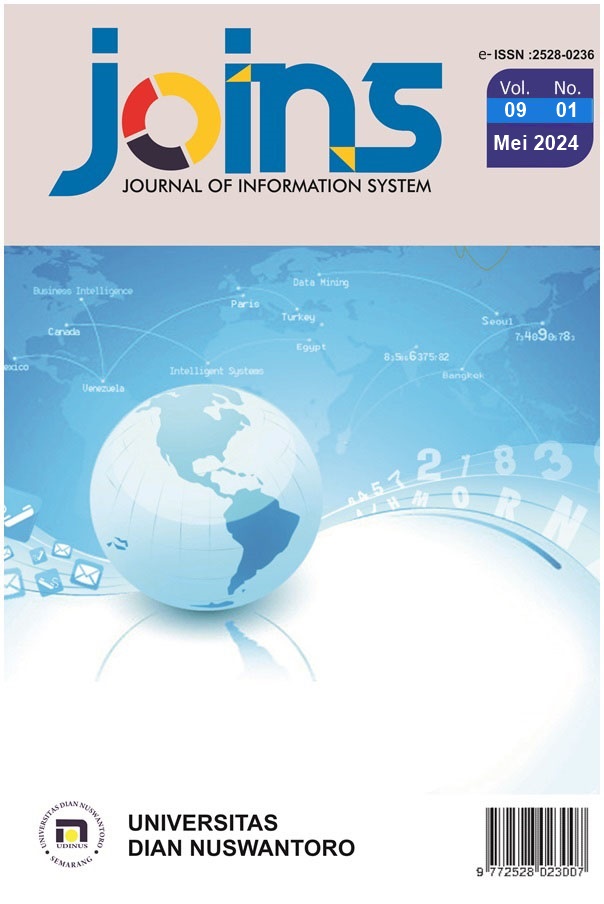Pengembangan UI/UX Sistem Pengelolaan Inventori Menggunakan Metode Design Thinking
DOI:
https://doi.org/10.33633/joins.v9i1.10311Keywords:
design thinking, usability testing, prototype, sistem inventoriAbstract
System development requires an interface design that suits the user, this is so that the system can be used fully without reducing or ignoring its main functions. Dwi Jaya Store which operates in the wholesale and retail product sales sector faces challenges such as managing suppliers which may be more than one supplier, managing product orders to suppliers based on inventory levels, managing product returns to suppliers if there are defects or damage, managing the traffic of goods from main warehouse to shops and report management. Dwi Jaya Store requires an inventory system that is easy to use but does not reduce the performance and function of the system. This research aims to produce a prototype inventory system that users use easily. This research uses the design thinking method, usability testing method, and Figma as a design tool. This research produced a prototype with a usability testing value of 78.4% which was included in the Good Application category.References
B. Kurniawan and M. Romzi, “Perancangan UI/UX Aplikasi Manajemen Penelitian Dan Pengabdian Kepada Masyarakat Menggunakan Aplikasi Figma,” J. Sist. Inf. Mahakarya, vol. 5, no. 1, pp. 1–7, 2022.
M. S. Hartawan, “Penerapan User Centered Design (UCD) Pada Wireframe Desain User Interface Dan User Experience Aplikasi Sinopsis Film,” JEIS J. Elektro Dan Inform. Swadharma, vol. 2, no. 1, pp. 43–47, 2022, doi: 10.56486/jeis.vol2no1.161.
M. A. Muhyidin, M. A. Sulhan, and A. Sevtiana, “Perancangan UI/UX Aplikasi MY CIC Layanan Informasi Akademik Mahasiswa Menggunakan Aplikasi Figma,” J. Digit, vol. 10, no. 2, pp. 208–219, 2020, doi: 10.51920/jd.v10i2.171.
M. A. Idris, G. P. Mahardhika, and B. Suranto, “Perancangan UI/UX Aplikasi Perangkat Bergerak Ivent Menggunakan Pendekatan HCD (Human Centered Design),” J. Autom., vol. 2, no. 1, pp. 287–293, 2021, [Online]. Available: https://journal.uii.ac.id/AUTOMATA/article/view/17377
M. Malewicz and D. Malewicz, Designing User Interfaces. HYPE4, 2020. doi: 10.1515/9783110689488-009.
I. N. Arifin, H. Tolle, and R. I. Rokhmawati, “Evaluasi Dan Perancangan User Interface Untuk Meningkatkan User Experience Menggunakan Metode Human Centered Design Dan Heuristic Evaluation Pada Aplikasi Ezyschool,” J. Pengemb. Teknol. Inf. dan Ilmu Komput., vol. 3, no. 2, pp. 1725–1732, 2019, [Online]. Available: http://j-ptiik.ub.ac.id
S. Tazkiyah and A. Arifin, “Perancangan UI/UX Pada Website Laboratorium Energy menggunakan Aplikasi Figma,” J. Teknol. Terpadu, vol. 8, no. 2, pp. 72–78, 2022, doi: 10.54914/jtt.v8i2.513.
I. A. Adha, A. Voutama, and A. A. Ridha, “Perancangan UI/UX Aplikasi Ogan Lopian Diskominfo Purwakarta Menggunakan Metode Design Thinking,” JOISIE J. Inf. Syst. Informatics Eng., vol. 7, no. 1, pp. 55–70, 2023.
F. C. Wardana and I. G. L. P. E. Prismana, “Perancangan Ulang UI & UX Menggunakan Metode Design Thinking Pada Aplikasi Siakadu Mahasiswa Berbasis Mobile,” JEISBI J. Emerg. Inf. Syst. Bus. Intell., vol. 03, no. 04, pp. 1–12, 2022.
T. Mulligan, UX/UI DESIGN 2021-2022 TUTORIAL THE COMPLETE STEP BY STEP GUIDE To UX/UI Design and Best Practices For designers with no Experience. 2021.
Shneiderman, Plaisant, Cohen, Jacobs, and Elmqvist, Designing the User Interface Strategies for Effective Human-Computer Interaction, 7th ed. Edinburgh: Pearson, 2018.
S. Branson, UX/UI Design Introduction Guide To Intuitive Design and User-Friendly Experience. 2020.
P. B. Deacon, UX AND UI STRATEGY A Step by step Guide on UX and UI design. 2020.
A. Saputra, “Penerapan Usability pada Aplikasi PENTAS Dengan Menggunakan Metode System Usability Scale (SUS),” JTIM J. Teknol. Inf. dan Multimed., vol. 1, no. 3, pp. 206–212, 2019, doi: 10.35746/jtim.v1i3.50.
M. A. Kushendriawan, H. B. Santoso, P. O. H. Putra, and M. Schrepp, “Evaluating User Experience of a Mobile Health Application ‘Halodoc’ using User Experience Questionnaire and Usability Testing,” J. Sist. Inf., vol. 17, no. 1, pp. 58–71, 2021, doi: 10.21609/jsi.v17i1.1063.
H. Alathas, “Bagaimana Mengukur Kebergunaan Produk dengan System Usability Scale (SUS) Score,” 2018. https://medium.com/kelasux/bagaimana-mengukur-kebergunaan-produk-dengan-system-usability-scale-sus-score-2d6843ca780a (accessed Feb. 25, 2024).
Downloads
Published
How to Cite
Issue
Section
License
Authors who publish with this journal agree to the following terms:
- Authors retain copyright and grant the journal right of first publication with the work simultaneously licensed under a Creative Commons Attribution License that allows others to share the work with an acknowledgement of the work's authorship and initial publication in this journal.
- Authors are able to enter into separate, additional contractual arrangements for the non-exclusive distribution of the journal's published version of the work (e.g., post it to an institutional repository or publish it in a book), with an acknowledgement of its initial publication in this journal.
- Authors are permitted and encouraged to post their work online (e.g., in institutional repositories or on their website) prior to and during the submission process, as it can lead to productive exchanges, as well as earlier and greater citation of published work (See The Effect of Open Access).

This work is licensed under a Creative Commons Attribution 4.0 International License.






















